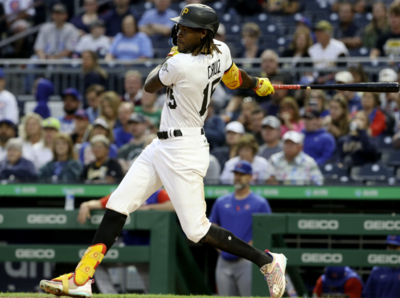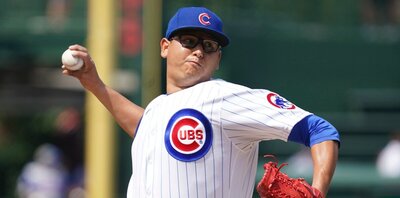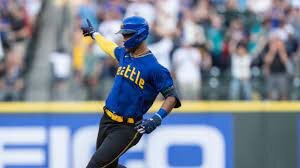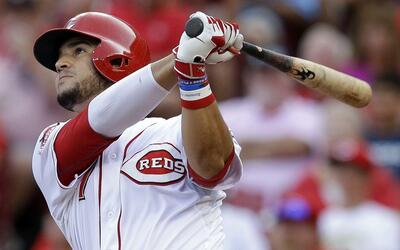Miguel Gonzalez (SP-BAL)- Gonzalez improved his record to 4-2 on Tuesday night after helping the Orioles to a 3-2 win over the Angels. He allowed only one run on four hits and a walk while striking out five in eight innings of work. The right-hander improved his ERA to 3.71, and there is some room for improvement even though his DIPS (4.32 FIP and 4.14 xFIP) might say otherwise. Gonzalez, who is still prone to the home run ball, has managed to improve his ground ball rate to a 45 percent. He has been able to maintain a .267 BABIP with the help of a below average line drive rate (17.4 percent). Even with a favorable BABIP, Gonzalez might be able to maintain this type of ERA considering his above average swinging strike rate (10.1 percent). His splitter gives him a reverse platoon split, so he is best utilized in starts against left-handed heavy lineups.
Matt Joyce (OF/DF-TB)- Joyce received a rare start against a left-handed starter and Tuesday night, and went 2-for-3 with a walk, a home run and two RBI to help lead the Rays to a 8-3 win over the Red Sox. The home run was his twelfth of the season, and he improved his slash line to .258/.343/.500 in the process. Joyce continues to have be a steady performer for the Rays, and he has improved his power numbers this season (.242 ISO). There has not been too much of a difference in his success this season. He continues to produce an above average amount of fly balls (46.2 percent), but his HR/FB ratio of 17.4 percent is the second best rate of his career. Joyce usually slows down in the second half of the season, but he should be able to reach a new career high in home runs this season even if his ratio slips a bit. Owners should expect him to finish with a similar slash line. His BABIP should improve (.259), but his strikeout rate (17.4 percent) might also trend upward considering he is still swinging and missing at a 9.3 percent rate.
Derek Holland (SP-TEX)- Holland, who is off to the best start of his career, turned in a poor performance on Tuesday against the Indians. He allowed four runs on nine hits and one walk while striking out four in 4.1 innings of work. The left-hander saw his ERA increase to 3.11, but his 2.60 FIP and 3.25 xFIP are still very impressive. Holland has taken the strides he made with his control in 2012 (2.36 BB/9 in 2013), and has paired it with an increase in strikeouts. He came into last night's start with a career best 10.6 percent swinging strike rate, and his strikeout rate of 8.57 K/9 is also a career best. Part of Holland's success has come from the fact he is featuring his slider more than 25 percent of the time, and dropping his fastball usage to a career low 57.7 percent.
Paul Konerko (1B/DH-CHW)- Konerko's struggles at the plate continued on Tuesday night as the White Sox lost to the Blue Jays by the score of 7-5 in extra innings. The veteran first baseman went hitless in five plate appearances while drawing a walk and striking out once. Konerko has only hit six home runs this season to go along with his .234/.298/.349 slash line. His 7.8 percent HR/FB ratio is at a career low 7.8 percent, which is significantly down from his career rate of 16.4 percent. I also do not know what to make of his .250 BABIP considering he is hitting the ball hard (27.5 percent line drive rate), and his fly ball rate (43.3 percent) has not been affected by infield fly balls (2.6 percent). His strikeout rate (15.4 percent) is also up a bit, but it should not be affecting his overall line in this way. Owners should be patient, and I would expect Konerko to go on tear soon.
Glen Perkins (RP-MIN)- Perkins recorded his fourteenth save of the season last night against the Phillies after throwing a 1-2-3 inning in which he recorded a strikeout. In only his second season in the role, Perkins has been one of the more consistent closers this season. The left-hander has pitched to 2.66 ERA this season, but his FIP (2.10) and xFIP (2.20) have been even better. He has posted a career best 13.31 K/9 with a 14 percent swinging strike rate, and he still has an excellent walk rate (2.28 BB/9). Perkins' fly ball tendencies are one of the few negative aspects of his game so far this season (30 percent ground ball rate), but owners should not take too much stock in that number considering the small sample size. Perkins should see his ground ball rate inch closer to his career rate of 42.3 percent over time.
Follow me on Twitter for baseball info and other miscellaneous ramblings.



































